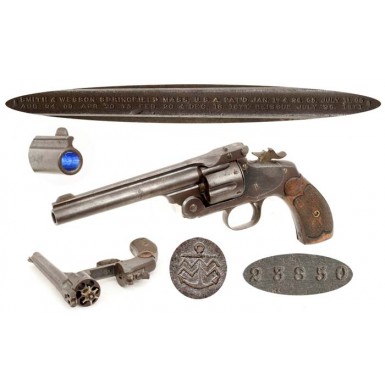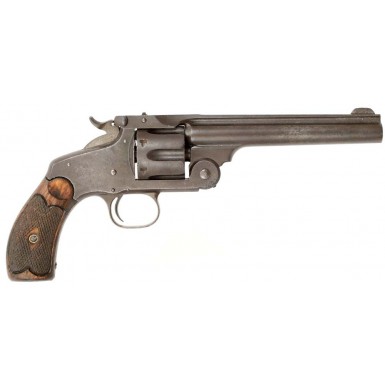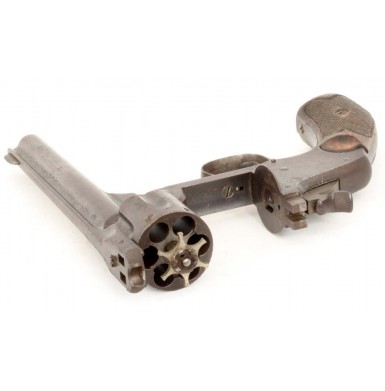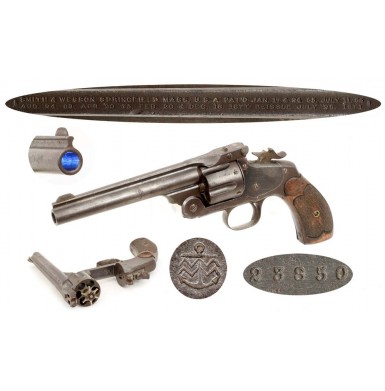Japanese Naval Contract Smith & Wesson New Model #3
- Product Code: FHG-1759-SOLD
- Availability: Out Of Stock
-
$1.00
In 1867, the Tokugawa Shogunate that had ruled Japan since 1603 came to an end and the period that came to be known as the Meiji Restoration (circa 1868-1912) began. This period of “Enlightened Rule” dramatically shifted the governmental power of Japan from the Shogun (the supreme military dictator) and the feudal lords under his direct control, who had controlled the country for more than two-and-half centuries, by returning the ruling power to the Emperor. Under the rule of the Tokugawa Shogunate a strict policy of isolationism had been enforced, with only limited contract between Japan and the outside world. This contact was primarily in the form of trade through the port of Nagasaki, which was the only Japanese port open to foreign vessels. Shogunate policy not only restricted trade to this single port, but it prohibited western visitors from entering the interior of the various Japanese islands. With the arrival of Admiral Mathew Perry in Edo Bay (now Tokyo Bay) in 1853, the Shogunate was forced to communicate with the western world on terms it was most certainly uncomfortable with. The appearance of Perry’s small flotilla of powerful warships full of marines and sailors armed with modern breechloading and repeating weapons made it woefully obvious to even the most backward thinking member of the Bakufu (the Shogunate’s ruling council) that a Japan with a clan based military system of samurai armed with swords was woefully incapable of resisting any serious western military incursion into the Japanese islands. Over the next decade, due to internal pressures brought to bear by more contact with the outside world, the power of the Tokugawa Shogunate waned and eventually the Shogun abdicated his power to the Emperor. The Emperor, with the help of his council and advisors, initiated a policy of modernization that would transform the Japanese military from nearly medieval status in terms of technology and organization to a world military power in about 50 years. One of the first tasks was to reorganize the military from clan dominated professional soldiers to a unified national force, organized along Prussian military lines, and to introduce general conscription so that the former samurai class of “professional soldiers’ served with other classes of citizens from Japanese society. The second major task was to arm and equip this new national army that pledged its allegiance to the Emperor and not some local Daimyo (a local feudal lord who had been a vassal of the Shogun) in a modern way. This meant that for the first time in centuries firearms were now to play a part in Japanese warfare. It had not been since the rise of the Tokugawa Shogunate in the early 1600s that firearms had played a major role in the Japanese military conflicts, and for the next 250 years the possession and use of firearms was strongly controlled by the Shogunate. The modernization of the military initially required the importation of firearms from western powers, as no significant firearms manufacturing industry was established in Japan. Early long arm purchases included thousands of muzzle loading English P-1853 Enfield rifle muskets as well as P-1856 Enfield rifles, primarily acquired as American Civil War surplus from dealers like Schuyler, Hartley & Graham of New York. These arms were quickly replaced by more modern rifles like the Spencer from American as well English Snider breechloading rifles and European arms like Dreyse needle rifles, French M-1866 Chassepot rifles and eventually French M-1874 Gras rifles. The Gras, in fact, became the basis for the first modern and indigenous Japanese military rifle, the Type 13 Murata rifle, which went into production in 1880 at the Tokyo Arsenal, which has been established in 1871. However, the Japanese military still relied upon foreign handguns to arms those soldiers to which they were issued. From the early days of western influence in Japan, after the Perry expedition, the revolvers produced by Smith & Wesson had found a strong market in that country. The earliest Smith & Wesson revolvers, the Model 1 .22RF and Model 2 (Old Model Army) in .32RF were both imported into Japan in some quantity. At least 1,550 of the No. 2 Old Army revolvers can be documented from Smith & Wesson ledgers as having been shipped to Japanese importers during their period of production, with the earliest recorded deliveries being to C. & J. Favre-Brandt of Yokohama in 1868. These guns are sometimes encountered with Japanese markings, including Meiji era gun registration marks or Imperial Chrysanthemums, indicating Japanese government (military) ownership. Smith & Wesson certainly viewed Japan as a potential customer for their product line, and certainly were involved in actively pursuing Japanese military contracts. However, it may well have been the fact that Russia adopted their own version of the Smith & Wesson Model 3 revolver (known as the Model 3 Russian or “Old Model Russian”) that pushed the Japanese military to adopt the Model 3 as well. Russia represented the closest potential major enemy for Japan, as well as the largest adversary in region to resist the Japanese push to expand their sphere of influence in their constant search for the natural resources that their home islands lacked. The Japanese military adopted the top-break .44 caliber “Russian” Model 3 Smith & Wesson revolvers as the “No. 1 Model Break Open Handgun” and would proceed to acquire several thousand of them over the next three decades. Due to the fact that these purchases took place over time, the guns technically belonged to four different model classes: Model 3 Russian 2nd Model, Model 3 Russian 3rd Model, New Model No. 3 Single Action and New Model No. 3 Frontier. It does not appear, however, that the minor differences between the variations was ever a basis for classification in Japanese service, as all were essentially the same model and were all chambered for the same .44 S&W Russian cartridge, with only minor improvements in the extraction system, minor differences in barrel lengths and other very minor changes mechanically and visually. The first of the Smith & Wesson Model 3 revolvers to be acquired by the Japanese government were some 5,000 Smith & Wesson Model 3 Russian 2nd Model revolvers that were purchased from the London based firm of H. Ahrens, who had offices and warehouse in Yokohama for the purposes of engaging in the Asian trade. These guns were purchased circa 1878 and shipped during the following months in 1878-1879. Examples of these revolvers are known with both Japanese Naval and Army markings. The next group of Japanese military purchased Smith & Wessons were some 1,000 Model 3 Russian 3rd Model revolvers that were again provided by H. Ahrens of Yokohama, and were shipped during 1878. The next model to be acquired by the Japanese military was a somewhat considerable quantity of the Smith & Wesson New Model No 3 Single Action revolvers. The first two shipments of Japanese military New Model No. 3 revolvers were also supplied by H. Ahrens. The first order was for 232 guns with a second order placed for 600 guns. Both orders were delivered for use by the Imperial Japanese Navy during 1879. This ended the relationship between H. Aherns and the Japanese military and all subsequent shipments of Smith & Wesson revolvers would be delivered by Takata & Company of Yokohama. Some 9,000 additional New Model No. 3 revolvers were delivered to the Japanese military by Takata in 12 shipments, delivered between 1884 and 1908, with the guns being sent to the army, navy, artillery and even seeing use with some other Imperial Japanese services including police and some diplomatic personnel. In all, the Japanese purchased about one third of the total production of the New Model No. 3 Single Action revolvers. The final variant of the .44 Smith & Wesson Model 3 revolver to be purchased by the Japanese military was the New Model No. 3 Frontier. These guns had originally been produced in .44-40 (.44 Winchester Center Fire) but due to disappointing sales and their availability in the Smith & Wesson warehouse, some 786 of the revolvers had their cylinders changed to .44 Russian and were included in shipments to Takata during 1895 and 1896 to help complete outstanding orders for Japanese military New Model No. 3 revolvers. According to the best possible research and estimates more than 17,232 Smith & Wesson Model 3 Russian revolvers in 4 variants were delivered for Japanese military use between 1878 and 1908. Even though the Japanese designed and manufactured Type 26 revolver was officially adopted in Meiji year 26 (1893), and technically replaced the Smith & Wesson revolvers in service, at least eight additional deliveries were made by Takata as long as fifteen years after the Type 26 was adopted. More than 6,100 Model 3 Smith & Wessons were delivered after the adoption of the Type 26. It was not until the Japanese adoption of the first Nambu pattern semi-automatic pistols in 1909 that the purchase of Smith & Wesson revolvers for military service came to an end. In many cases the Smith & Wessons remained in front line service rolls through the end of the World War I era, at which time they were relegated to secondary rolls, where they remained in service through the end of World War II. As a result, some of the Model 3 revolvers saw service for more than half a century, and some had a service life as long as 60 years! This explains why most examples encountered today show significant service wear, little original finish and often show mixed assembly (serial) numbers, the result of some revolvers being cannibalized for parts to keep other revolvers functioning. These guns are very scarce and desirable for Japanese military collectors today, as Japanese military marked Model 3 Smith & Wessons rarely appear on the market. For a serious collector of Japanese military handguns, a Model 3 is the first one you need in your collection, as it was the first major acquisition of a standardized handgun for general issue to Japanese forces. The fact that many of the guns remained in service through the end of World War II is a testament to the quality of the Smith & Wesson design and workmanship. A complete collection of Japanese martial handguns that covered the period from the Russo-Japanese War through World War II should include both a Model 3 Smith & Wesson and a Japanese Type 26 revolver, in addition to the various Nambu semi-automatic pistol variants and end with a Type 94.
Offered here is a classic example of a Smith & Wesson New Model No. 3 Revolver with Japanese Naval Markings. The gun is a 6 ““ barreled blued example. Barrel lengths on known examples of Japanese military Model 3 revolvers include 6”, 6 ““ and 7” with both blued and nickeled finishes, although blued is the most commonly encountered. The gun bears the serial number 23850 on the bottom of the butt, and this same number is also found on the upper rear of the top strap, integral with the barrel. Based upon the research by Francis Allan, Chip Goddard, Takehito Jimbo, Doss White & Dr. Stanley Zielinski, published in their book Japanese Imported Arms of the Early Meiji Era, we know that the most of the guns in that serial number range were part of two shipments from Smith & Wesson to Takata & Company on June 27 and August 18 of 1887. A total of 3,064 guns were included in these two shipments, with the revolvers falling in the 16,402-25,000 serial number range. As is quite typical when these rare guns are encountered today, the revolver exhibits a number of mixed number (mismatched) parts, indicating that it was rebuilt during its Japanese military service by scavenging parts from other revolvers. The cylinder is serial numbered 24579, and based upon the published research of Francis Allan, et. al., we know that the cylinder originated with a gun in the same shipment as the frame and barrel. The barrel release catch is serial numbered 31804, and again relying on the above mentioned serial number data, we can determine that this part originated on a gun that was shipped to Takata & Company on October 28, 1896. That shipment included 1,955 guns in the 30,001 to 32,536 serial number range. The grips are not numbered internally, other than with a large 4 inside of both grip panels. This does not appear to be a factory applied marking, but rather is typical of the additional numerical markings sometimes encountered on Japanese military revolvers of the era. Interestingly the Japanese military purchased Smith & Wesson New Model No. 3 serial number 23,830 (only 20 numbers from this gun) survives today and has a mismatched barrel and cylinder. Japanese military marked New Model No. 3 with the serial number 23,817 (only 33 numbers away) survives as well, and also has a mismatched cylinder. These three revolvers, all in such close proximity to each other in serial number and part of the same original shipment, all have replaced cylinders, suggesting that there may have been a parts or workmanship issued with some of the cylinders in that original batch of revolvers. All three guns appear to have been delivered as part of the June & August 1887 shipments, and all three bear Japanese Imperial Naval markings. The bottom of the frame, forward of the triggerguard, is stamped with the Japanese Imperial Naval ownership mark of an anchor. This version has two serrated lines that cross through the main part of the anchor’s body, giving the mark the collector nickname the “Wavy Anchor”. This variant of the Japanese Naval anchor mark is that of the Kure Naval District. The Kure Naval District was established in 1889 as the 2nd Naval District, with a shipyard built there in 1895 and an arsenal completed there in 1903. The naval base is located in the Hiroshima prefecture, with the anchorage being in part of Hiroshima Bay. The “Wavy Anchor” marking is unique to weapons issued by that Japanese naval base. The top rib of the revolver is roll stamped in two lines, flanked by a pair of Maltese crosses and reads:
SMITH & WESSON SPRINGFIELD MASS. U.S.A. PAT’d JAN 17 & 24. 65. JULY 11. 65
AUG. 24. 69. APR. 20. 75. FEB. 20 & DEC. 18. 1877. REISSUE JULY 25. 1871.
The barrel legend remains fully legible and is clearly stamped. No other external marks are present on the revolver. Inside the bottom of the frame the a tiny 5 is stamped, which is probably a factory inspection mark.
The revolver is in about VERY GOOD+ overall condition and is typical of the condition these rare revolvers are encountered in when they are found for sale. The metal surfaces of the gun have a thick brown patina, with some flecks and traces of the original bright blue finish, mostly on the frame behind the recoil shield and in protected areas like the recess where the barrel rib meets the barrel, and in cylinder flutes. Taken together all these flecks and minor speckles of blue only add up to a trace amount, not even 5%. The balance of the gun has the aforementioned thick brown patina, with some scattered patches of light surface oxidation and mild roughness. There is some scattered pinpricking present on the metal, as well as some scattered light pitting. The most noticeable areas of pitting are at the front sight (where it is fairly moderate), at the frame hinge and the frame forward of the cylinder, on the cylinder itself, and on the backstop where it is fairly deep. It is interesting to note that although the barrel catch and cylinder are mismatched period replacements, they have been with the revolver for so long that the patina matches perfectly and short of inspected the numbers there would be no way to visually determine that all of these components did not leave the factory together. The revolver is mechanically EXCELLENT and functions perfectly on all positions. The revolver times, indexes and locks up exactly as it should. The break open action locks securely together with no wobble or sloppiness and opens smoothly when released. The automatic extractor functions smoothly and correctly as well. The revolver retains a FINE condition bore, which is mostly bright and still retains crisp, sharp rifling. The bore shows some very lightly scattered pitting and a couple of tiny patches of more moderate oxidation, but really remains in wonderful condition. According to the above mentioned book, this is not uncommon, as the revolvers were apparently carried and handled much more than they were typically shot. The revolver was never fitted with a lanyard ring, a typical modification made in Japan to many of their military revolvers. Notes included in the appendix of the Allan book indicate that the two other revolvers cited above, which are so close in serial number to this one, did not have a lanyard ring fit to them either. The two-piece checkered walnut grips may or may not be original to the revolver, as they bear no factory numbering it is impossible to tell. Although most references suggest smooth walnut grips are appropriate for this model of Japanese contract revolver, extant examples clearly illustrated in the book by Allan, et. al. indicate that both smooth and checkered walnut grips were used on Japanese contract New Model No. 3 revolvers, as well as checkered hard rubber grips. As their book is certainly the most in-depth and exhaustive on the subject, I will defer to the opinion of those authors. The grips are in VERY GOOD+ to NEAR FINE condition. They are solid, complete and free of any breaks, cracks or repairs. The checkering remains crisp and well defined throughout with only light wear, commensurate with the condition of the balance of the revolver.
Overall this is a really nice, crisp and untouched example of a late 19th century Japanese Naval marked Smith & Wesson New Model No. 3 Single Action Revolver. The gun is complete with all original period parts, from at least two different Takata & Company deliveries to the Japanese military, and although the numbers are mismatched, that is perfectly normal and acceptable, just like with a Colt “Artillery” alteration revolver. These guns rarely show up on the market for sale and a great find for a collector of 19th and early 20th century Japanese military arms. Rarely can you find an item for sale that represents not only the early part of the Meiji restoration in Japan, but also the Russo-Japanese War, as well both the First & Second World Wars. While not a frontline issue weapon during World War II, this revolver is still as appropriate to a Second World War collection of Japanese arms as any of their “last ditch” and homeland defense improvised weapons. If you collect Japanese military handguns, you can reasonably argue that this is the first “bookend” in that collection, and that all other modern Japanese military handguns evolved and were issued after this one. Don’t miss your chance to obtain a nice, well-marked example of a Japanese Naval Smith & Wesson New Model No. 3 Revolver, a gun you might not see again for sale for some time.
SOLDTags: Japanese, Naval, Contract, Smith, Wesson, New, Model, 3






